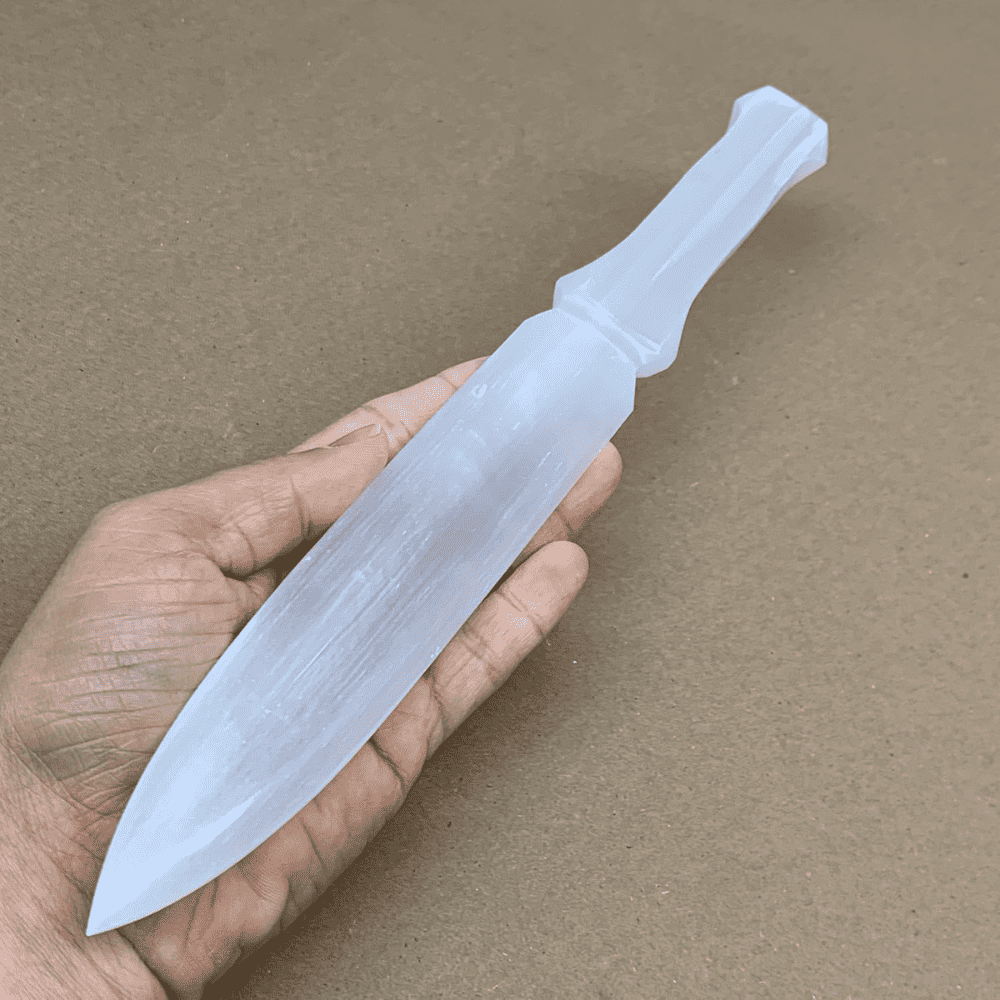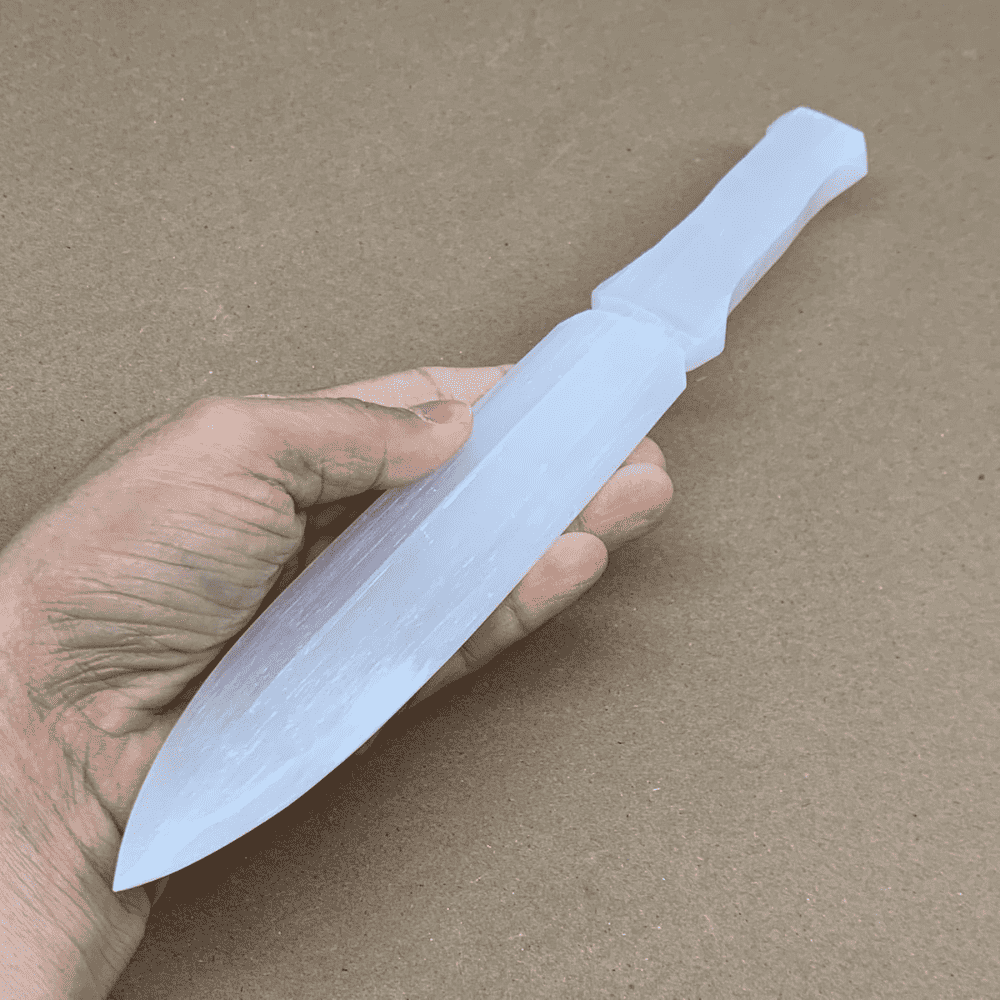What is Selenite and Why is This Knife Made from It?
Selenite is a naturally occurring form of gypsum crystal known for its pearly white color and soft sheen, often referred to as “satin spar” due to its smooth, silky appearance. This handcrafted knife, measuring 11.5 inches in length and weighing approximately 193 grams, is made from untreated selenite directly sourced from Moroccan quarries. Unlike synthetic or dyed variants, this crystal remains in its natural state, retaining its raw energy and unaltered texture.
Because selenite is a soft mineral (Mohs hardness 2), it is not used for cutting but rather for decorative and metaphysical purposes. It holds a long-standing reputation in crystal traditions for promoting clarity, calm, and energetic cleansing. The non-metallic composition and natural sheen of the blade give it a clean aesthetic that suits minimalist decor as well as spiritual settings.
- Natural untreated satin spar selenite
- Handcrafted from Moroccan crystal deposits
- Visually soft, yet symbolically strong
- Not designed as a cutting tool
How is This Knife Handcrafted and Why Does It Matter?
Each selenite knife is shaped and polished manually by artisans in Morocco. The handcrafted process involves selecting solid pieces of crystal and sculpting them into dagger-like forms using traditional tools. This approach ensures that every piece is slightly different in shape and finish, making each item a one-of-a-kind collectible.
The significance of handcrafting lies in the preservation of natural texture. Rather than smoothing down every ridge or flaw, craftsmen leave subtle natural striations that enhance authenticity. There are no industrial machines used for mass production, which not only ensures ethical labor practices but also maintains the spiritual value attached to handcrafted crystal artifacts.
- Carved by skilled Moroccan artisans
- Every knife has a unique finish
- Preserves natural lines and shapes
- Traditional craftsmanship, no machines used
How Can This Be Used in Interior Decoration?
The selenite knife offers visual interest for tabletop decor, shelf styling, or as part of a centerpiece. Its clean white tone works with a variety of color palettes, especially those involving earth tones, neutral shades, or natural woods. The reflective properties of satin spar catch and scatter light softly, making it ideal for spaces designed to feel open and serene.
Placed on a wooden tray, next to candles, or within a glass cabinet, it can serve as a talking point in living rooms, studios, or meditation rooms. Because of its cultural and spiritual associations, it also fits well in spaces curated with intention.
- Complements neutral or minimalist aesthetics
- Reflects light subtly in natural-lit areas
- Adds texture and story to modern interiors
- Works well with wood, stone, or linen materials
What Role Does Selenite Play in Metaphysical Practices?
Selenite is often considered a cleansing and energy-purifying crystal. It’s thought to help clear negative energy from spaces, objects, and even the aura of individuals. While many crystal users rely on small selenite wands or chunks, the dagger shape offers a symbolic tool for energy direction and focus.
Some users incorporate it in rituals, visualizing the dagger cutting through stagnant energy or protective barriers. Others place it near entryways to “guard” the home or next to electronics to counterbalance electromagnetic stress. While interpretations vary, the symbolic use of the knife enhances engagement in metaphysical routines.
- Used for spiritual cleansing and energy alignment
- Common in protective rituals and grid setups
- Represents clarity, intention, and focus
- Ideal for use in sacred or meditative spaces
How Does the Knife Fit in a Collectible or Display Context?
For collectors of crystals or handmade stone objects, this item stands out due to its unique shape and origin. Selenite daggers are less common than polished spheres or towers, which makes this design more desirable for those building a diverse display. The Moroccan origin further boosts appeal, as the region is known for high-quality satin spar.
The knife can be grouped with other figurines, displayed alongside a crystal collection, or placed in a shadow box with desert rose stones, another gypsum form from the region. With its symbolic form and natural finish, it becomes both a sculptural object and a cultural artifact.
- Suitable for curated collections
- Adds variety to standard crystal displays
- Unique due to shape and regional source
- Matches well with desert rose and gypsum pieces
What Makes the Handle and Structure Practical?
The knife is formed from a single piece of stone, so the handle is carved directly into the same block of selenite. This reduces the risk of breakage at seams or glued joints. The handle features slight ridges to prevent slipping, aligning with the listed “non-slip” feature, even though the item is not used as a weapon or utility knife.
Although delicate in terms of mineral composition, the dagger feels substantial when held. The weight and dimensions allow it to sit securely when placed flat, preventing rolling or tipping. This adds to its practicality as a decor or ritual object, where stability matters.
- Single-piece carved design for durability
- Subtle handle ridges improve grip
- Balanced weight helps with secure placement
- Non-slip form without added materials
Why is Moroccan Selenite Especially Valued?
Morocco is one of the most respected sources of natural gypsum crystals, especially satin spar selenite. The dry climate and vast deposits yield crystals with high transparency and minimal impurities. Artisans in this region have been working with natural stone for generations, particularly in carving objects with symbolic or spiritual significance.
The selenite from Morocco typically has longer striations and a more pronounced silky sheen compared to other sources. This gives the finished knife a higher aesthetic value. Provenance from this region adds credibility and appeal, especially for collectors and crystal enthusiasts who value authenticity.
- Selenite sourced from rich Moroccan gypsum deposits
- Known for high clarity and visual softness
- Long-standing tradition of stone carving in region
- Reliable and traceable origin
What Dimensions and Weight Make This Piece Functional?
At 11.5 inches in length, 1.3 inches in width, and 0.5 inches in thickness, this dagger maintains an ideal ratio for being both visible and manageable. The 193g weight provides a reassuring sense of presence without feeling overly heavy. These measurements make the knife adaptable for both handheld and flat-surface use.
It fits comfortably in display boxes, on wall shelves, or within decorative arrangements. The slim form allows for layering with books, trays, or textiles without taking up unnecessary space. Its proportion also supports balanced alignment in visual layouts.
- Lightweight but noticeable at 193g
- Easy to arrange with other decor elements
- Compact size for multiple room settings
- Not too bulky for personal altars or trays
How Does This Product Align with Ethical and Natural Standards?
The knife is made from untreated stone—no dyes, coatings, or synthetic chemicals are applied. This maintains its natural energy and mineral integrity. Hand carving further reduces reliance on industrial…








Reviews
There are no reviews yet.